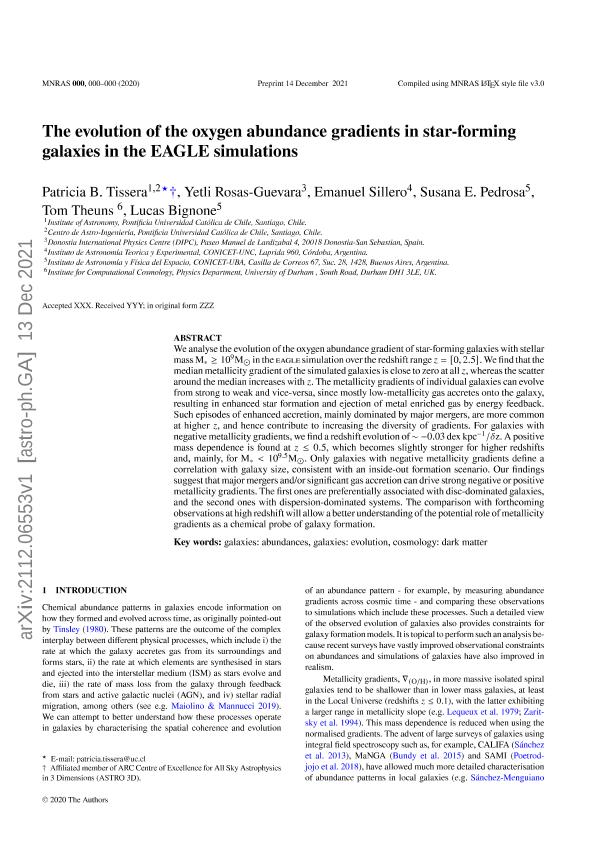Artículo
The evolution of the oxygen abundance gradients in star-forming galaxies in the EAGLE simulations
Tissera, Patricia Beatriz ; Rosas Guevara, Yetli; Sillero Ros, Guillermo Emanuel
; Rosas Guevara, Yetli; Sillero Ros, Guillermo Emanuel ; Pedrosa, Susana Elizabeth
; Pedrosa, Susana Elizabeth ; Theuns, Tom; Bignone, Lucas Axel
; Theuns, Tom; Bignone, Lucas Axel
 ; Rosas Guevara, Yetli; Sillero Ros, Guillermo Emanuel
; Rosas Guevara, Yetli; Sillero Ros, Guillermo Emanuel ; Pedrosa, Susana Elizabeth
; Pedrosa, Susana Elizabeth ; Theuns, Tom; Bignone, Lucas Axel
; Theuns, Tom; Bignone, Lucas Axel
Fecha de publicación:
12/2021
Editorial:
Oxford University Press
Revista:
Monthly Notices of the Royal Astronomical Society
ISSN:
0035-8711
Idioma:
Inglés
Tipo de recurso:
Artículo publicado
Clasificación temática:
Resumen
We analyse the evolution of the oxygen abundance gradient of star-forming galaxies with stellar mass M*≥10 9 M ⊙in the EAGLE simulation o v er the redshift range z = [0, 2.5]. We find that the median metallicity gradient of the simulated galaxies is close to zero at all z, whereas the scatter around the median increases with z. The metallicity gradients of individual galaxies can evolve from strong to weak and vice versa, since mostly low-metallicity gas accretes on to the galaxy, resulting in enhanced star formation and ejection of metal-enriched gas by energy feedback. Such episodes of enhanced accretion, mainly dominated by major mergers, are more common at higher z and hence contribute to increasing the diversity of gradients. For galaxies with ne gativ e metallicity gradients, we find a redshift evolution of ∼-0 . 03 de x kpc -1 /δz. A positiv e mass dependence is found at z ≤0.5, which becomes slightly stronger for higher redshifts and, mainly, for M*< 10 9 . 5 M ⊙. Only galaxies with ne gativ e metallicity gradients define a correlation with galaxy size, consistent with an inside-out formation scenario. Our findings suggest that major mergers and/or significant gas accretion can drive strong ne gativ e or positiv e metallicity gradients. The first ones are preferentially associated with disc-dominated galaxies, and the second ones with dispersion-dominated systems. The comparison with forthcoming observations at high redshift will allow a better understanding of the potential role of metallicity gradients as a chemical probe of galaxy formation.
Palabras clave:
DARK MATTER
,
GALAXIES: ABUNDANCES
,
GALAXIES: EVOLUTION
Archivos asociados
Licencia
Identificadores
Colecciones
Articulos(IAFE)
Articulos de INST.DE ASTRONOMIA Y FISICA DEL ESPACIO(I)
Articulos de INST.DE ASTRONOMIA Y FISICA DEL ESPACIO(I)
Articulos(IATE)
Articulos de INST.DE ASTRONOMIA TEORICA Y EXPERIMENTAL
Articulos de INST.DE ASTRONOMIA TEORICA Y EXPERIMENTAL
Citación
Tissera, Patricia Beatriz; Rosas Guevara, Yetli; Sillero Ros, Guillermo Emanuel; Pedrosa, Susana Elizabeth; Theuns, Tom; et al.; The evolution of the oxygen abundance gradients in star-forming galaxies in the EAGLE simulations; Oxford University Press; Monthly Notices of the Royal Astronomical Society; 511; 2; 12-2021; 1667-1684
Compartir
Altmétricas



